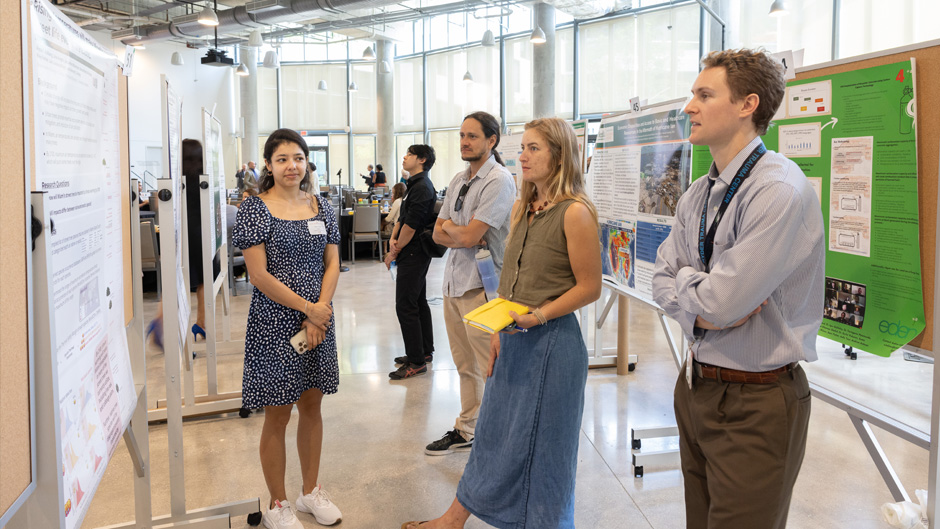From research that examines the link between indoor environmental conditions and dry eye disease to an investigation on the effects of meteorological factors on asthma in Miami, the Climate and Health Symposium held Friday on the University of Miami Coral Gables Campus featured dozens of posters on research by faculty members and students that addresses climate’s impact on human health.
But the climate crisis impacts more than people; it also harms other living organisms like trees, which help remove carbon dioxide from the air and help reduce urban heat islands by cooling the environment.
Lina Aragón, a Ph.D. student in biology who is studying climate change’s impact on plant distribution in the Andes mountains, is aware of that fact better than anyone. At Friday’s symposium, she presented her team’s research on the way in which climate change will increase the frequency of heat stress on urban tree life.
“Air temperatures in Miami are already near the upper thermal tolerance for many trees, and by the year 2100, maximum air temperatures are expected to increase by 2 degrees to 4 degrees Celsius,” Aragón said. “These high temperatures will push some trees over the edge, changing Miami’s iconic tree community.”
As part of their research, she and her team assessed the risk of global warming on 96 native and 147 exotic tree species commonly planted in Miami, finding that the city will be too hot for 16 percent to 42 percent of those tree species under 2 degrees or 4 degrees Celsius of warming, respectively.
“Native tree species will be disproportionately impacted by warming, as Miami will become inhospitable for 27 percent to 48 percent of natives compared with 10 percent to 37 percent of exotics,” Aragón said. “If we want to maintain a healthy community of urban trees capable of providing ecosystem services such as shade and mitigating heat, we must identify and promote the use of native tree species that will prosper in the Miami heat.”
She and her team were inspired to conduct their research after reading the Nature Communications paper “Climate change increases the global risk to urban forests.”
“The dataset used by that paper did not include a good representation of trees from tropical cities, so we decided to see if, by using the same methodology with a better list of species from Miami, we could find the same effects and understand the effect of increasing temperatures in the city,” said Aragón, noting that principal investigator, Kenneth Feeley, associate professor of biology in the College of Arts and Sciences and director of the John C. Gifford Arboretum, proposed the idea of the study as lab project.
“The poster presentation at the Climate and Health Symposium was our first time presenting our research, and we were glad to see that people are interested in protecting the trees of the city, given the multiple ecosystem services they provide,” she said.
Once Aragón and her team of other graduate students are confident about their findings, they plan to share a report with Miami-Dade County Mayor Daniella Levine Cava and resiliency officials in South Florida. They also plan to publish their research in a journal geared toward students.
Other posters highlighted climate change’s impact on human health.
Rebecca Shakour, a second-year Miller School of Medicine student in the M.D./M.P.H. program, is a coinvestigator on the study “Disaster Preparedness for Climate-Driven Hurricanes for Patients with End-Stage Kidney Disease,” which was featured at the symposium.
Customized disaster preparedness, Shakour noted, is a critical unmet need for end-stage kidney disease (EKSD) patients who require hemodialysis treatments at a dialysis center. But stronger and wetter Atlantic hurricanes are putting those patients at risk, disrupting clinical services. What’s more, airborne COVID-19 transmission complicates hurricane evacuation and sheltering. “This complex risk landscape requires tailored approaches to disaster preparedness for patients, clinicians, and dialysis providers,” she said.
As part of their study, Shakour and others reviewed literature on the intersection of ESKD, climate change, hurricane hazards, COVID-19, and disaster preparedness. They devised a study involving focus groups of ESKD patients, and they also interviewed dialysis providers and clinicians, questioning them about their Hurricane Ian experiences.
“We developed a survey that examines ESKD patients’ hurricane threat appraisal, adaptation appraisal, hurricane experience, and disaster preparedness,” she said. Patient demographics and mental health scales were also included.
“The major findings were that lessons have indeed been learned based on disaster experience, resulting in efficient approaches for dialysis providers to safeguard their patients,” Shakour said. “Dialysis centers alert and equip each of their patients—they see every patient three times weekly—on what to pack and what to do, and they pre-dialyze them before the storm hits.”
The providers in the study, she noted, have contingency plans to handle power outages and possible water shortages or contamination. “They provide lodging and security for their staff to be close to the dialysis centers to reopen immediately after the storm passes. And they have access to first-responder quality communications to let each patient know when and where dialysis centers have reopened,” Shakour said. “Using this well-developed system, half of the 232 closed dialysis centers opened within two days following Hurricane Ian’s landfall and 99 percent opened within five days. This system works to maintain life and health for ESKD patients.”
Shakour was initially interested in nephrology during the early stages of her medical school education. “As an M.D./M.P.H. student, I was paired with a faculty capstone advisor, Dr. James M. Shultz, who has extensive expertise in disaster preparedness for medically vulnerable patient populations,” she explained. “Therefore, I decided to pursue the intersection of hurricanes and patients requiring hemodialysis, which also provided me the opportunity to work with Dr. Zain Mithani, who has been an instrumental part of our work thus far.”

